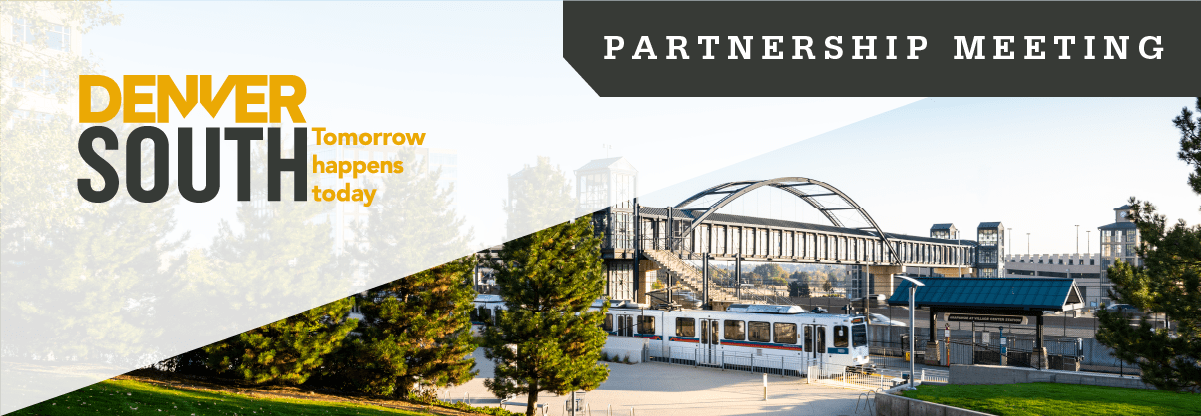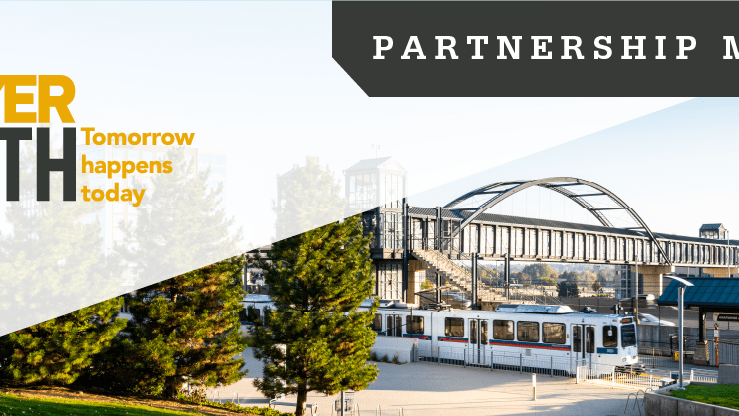As Denver South continues to grow and flourish, transportation solutions have become more relevant than ever. We—and our stakeholders—are continually looking to the future, to ensure the infrastructure we have is ready for tomorrow’s businesses and residents. With this in mind, our October Partnership Meeting was designed around Constructing the Future, and offered attendees a deep dive into the current and future transportation projects in the region. These projects are designed to not only facilitate easier commutes for those who currently live, work, and play in the region, but are also being designed with a mind to the region’s future.
The Colorado Department of Transportation’s (CDOT) Region 1 is the state’s smallest region within the CDOT system, yet it covers an area in which 2.9 million Coloradans live—including Denver South. The work their team does is therefore critical to the flow of traffic and people throughout our region. Stephanie Alanis, Program Engineer for CDOT’s Region 1, kicked off our October Partnership Meeting by emphasizing the importance basic maintenance plays in ensuring the 4,200 miles of roads and bridges Region 1 oversees are in prime operational condition; in fact, over half their budget is dedicated to maintenance and upkeep. By keeping its infrastructure maintained, CDOT is able to work towards their goals of roadway safety and resilience; that is, the ability to keep roads open and functional. Another key focus is to address bottlenecks while enhancing multimodal transit opportunities in the region. Alanis highlighted a number of key projects her team is working on that impact Denver South, including the I-25 South Gap Project, the US 85 Highway Widening, and the Lone Tree and Castle Rock Mobility Hubs. Alanis also noted that her team is continually working on smaller projects that have a low fiscal impact but a high impact on improved traffic flow and safety, such as the safety improvements being made on CO 83. Together, these projects are designed to contribute to a smooth flow of traffic across and within Denver South.
One of the projects CDOT is working on in conjunction with Douglas County, the City of Lone Tree, and Denver South is the Lincoln Avenue and I-25 Interchange. To dive deeper into this project Dan Raine, Mobility Manager of the City of Lone Tree, and Zeke Lynch, Traffic Division Manager of Douglas County, walked attendees through this project, branded as Advancing Lincoln Avenue. Raine underscored the importance of this project, citing both the existing and projected growth around this already-busy interchange. He noted that, in addition to facilitating traffic flow, one of the goals of Advancing Lincoln Avenue is to better integrate the interchange with the multimodal infrastructure that surrounds it. Already, Bustang stops near this interchange, and both Douglas County and Lone Tree see this project as an opportunity to further integrate the community into the region’s transportation infrastructure. Lynch dug into the four proposals being considered for the intersection, highlighting the desire to facilitate a smooth traffic flow both for existing traffic at the intersection as well as for future traffic generated by the upcoming development of the Lone Tree City Center. The committee’s goal is to have a recommended course of action by the end of the year.
Jimmy Gilman, Director of Government Partnerships for Spin, rounded out the morning’s presentations by presenting a vision of 15-minute cities – cities where everything a person needs is within a 15-minute walk, scooter, or bike ride. Although this is currently not viable for many, Gilman believes it is attainable due to the growing range of micromobility options available to commuters. To highlight the potential of micromobility, Gilman cited two locales where Spin recently launched service—the Meridian Business Park in Denver South and the City of Fort Collins. The Meridian program launched in November 2021 with 75 e-scooters and 25 e-bikes, available to residents and employees around the clock. Since its launch, Spin has discovered its fleet has been predominantly used as a last mile transportation solution from the RTD light rail line, providing that link from the station to the office or home. This is borne out by data that reflects peak usage occurring during the morning and evening rush hours. In Fort Collins, Spin’s fleet covers a larger territory, and has proved to be a viable transportation option for college students seeking a faster way to get across campus. Due to the program’s size and demographics, Spin was also able to incorporate two new initiatives aimed at inclusiveness into their Fort Collins program—a sub-fleet of adaptive vehicles for those with accessibility challenges, as well as a tiered pricing structure to offer discounts to those who receive government assistance. The goal is to ensure micromobility remains a viable, accessible transportation option for all. Ultimately, both the Meridian and Fort Collins programs have demonstrated to Gilman that micromobility is a viable first/last mile option, and is effective in areas that are not dense or urban in design. These successes lead Gilman to believe that micromobility programs can be effective in a wide range of geographic settings.
We thank everyone who was able to join us for our last partnership meeting of 2022, and hope you can join us for holiday party December 1st at the Dome at AMG Trust National Bank. Event details and registration can be found here.
Presentation decks for each speaker can be found below:


